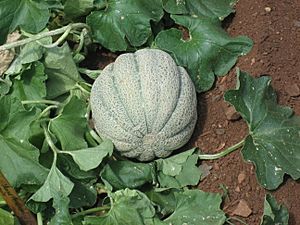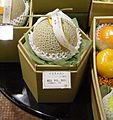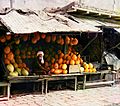Muskmelon facts for kids
Quick facts for kids Muskmelon |
|
|---|---|
 |
|
| Scientific classification | |
| Kingdom: | |
| (unranked): | |
| (unranked): | |
| (unranked): | |
| Order: | |
| Family: | |
| Genus: |
Cucumis
|
| Species: |
C. melo
|
| Binomial name | |
| Cucumis melo |
|
Muskmelons (Cucumis melo) are a type of melon. Cantaloupes are a popular type of muskmelon, but there are other types. They come from Iran and other places nearby. They were transported west to Europe near the time of Christ's birth.
The name of the muskmelon comes from the words "musk," which means "perfume" in Persian and "melon," which is French and comes from a Latin word that means "apple shaped melon."
Contents
History
Muskmelons are native to Iran, as well as parts of India and Afghanistan. The first known mention of the muskmelon was in Greece in the 3rd century BC. There is an old Egyptian painting that shows a fruit some people think was a muskmelon. In the first century AD, Romans knew about the muskmelon, and both the Greeks and Romans found that it could be used as medicine or to eat. At about this time, China also found out about the muskmelon.
During the Middle Ages the muskmelon spread across Europe to as far west as Spain and Christopher Columbus brought seeds of it to the Caribbean in 1494. In the 1600s it was being grown across North America by the Spanish, the English and Native Americans. By 1650 the muskmelon was being grown in Brazil.
Taste
Muskmelons can have a very good taste or a very bad one, depending on each fruit. The species might have spread slowly because a lot of muskmelons taste bad. In 1513, a Spanish writer said of the muskmelon that "the good [muskmelons] are like good women, and the bad like bad women."
Images for kids
-
Japanese "crown melon" intended as a high-priced gift: The pictured crown melon is 6300 yen, or about US$59
-
The Armenian cucumber, despite the name, is actually a type of melon.
-
Melon vendor in Samarkand (between 1905 and 1915)
See also
 In Spanish: Cucumis melo para niños
In Spanish: Cucumis melo para niños








